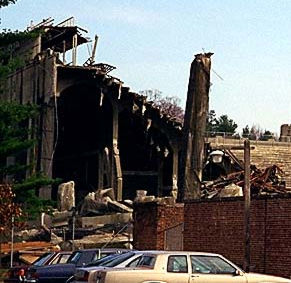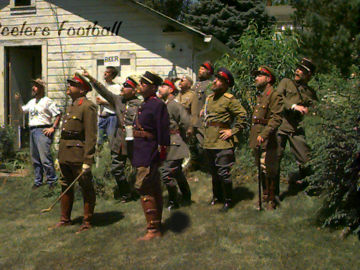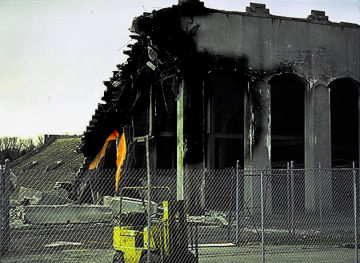FLYING SAUCER TERRORIZES U of E FOOTBALL GAME:
IS AERODYNE RESPONSIBLE?

The crumpled ruins of the University of Emmetsburg Sparky Field Stadium silently testify to the fiery crash of a vintage WWI aircraft from the sky caused by a UFO!
The weather that weekend was unusually mild for northwest Iowa in mid-November. It was ideal, in fact, for the special extended half-time ceremonies planned by University officials and co-sponsored by Smegmov Vodka and Nietzsche Breweries, to commemorate the eightieth anniversary of the Armistice that ended the First World War on 11 November, 1918.
"It was a truly inspired event," said U of E President Neville Angstrum. "We figured it would be a good way to remember that World War 1 helped pave the way for World War II, and then the Cold War, which led to so many Government grants and endowments to the University of Emmetsburg."
As both teams quit the field at the end of the first half, 12-7 Peelers leading, the U of E's Marching Band made their appearance to begin the festivities with a medley of World War I songs.
Then, mobile trenches and barbed wire were wheeled into the stadium and WW1 reenactors, authentically dressed and equipped in correct period uniforms (most hand-made by Third Eye Over Iowa Staff Writer, Richard C. Putnam), weapons and accouterments recreated highlights of the Great War on a year-by-year basis, all accompanied by appropriate music provided by the University Marching Band, artillery fire, and voice over narration.
Beginning with a recreation of Archduke Franz Ferdinand's assassination at Sarajevo, and continuing with brief reenactments of the battles of Mons, the Marne, and Tannenburg in 1914, the invasion of Gallipoli and sinking of the RMS Lusitania in 1915, the battles of Verdun, the Somme and the Brusilov Offensive of 1916 (which included a heart stopping, rousing charge by the Smegmov Vodka Imperial Cossack Horse Drill Team).
By the time 1917 rolled around after the first twenty minutes, and to commemorate the United State's entry into the war, a special ceremony was held. With the local American Legion providing an honor guard, Emmetsburg's last surviving Great War veterans were escorted onto the field.
Local dignitaries, led by Emmetsburg mayor Norbert Llewots, and reenactors dressed as the leaders and generals of the powers in conflict, paid homage to the four men. One of the veterans, Harold O'Brien, age 104, had to be wheeled to the ceremony in a special hospital bed complete with monitors, IVs, life-support systems and nurses appropriately dressed in period Red Cross uniforms, all provided by Smegmov Vodka and Nietzsche Beer.
Or words to that effect.

World War I Reenactors gawk and stare in wide-eyed amazement as a strange "discoid" aircraft drives "Bubba" Arsloch from his Fokker D-VII, sending it crashing into the scoreboard.
At this point, Yuri Merriam, spokesman for Smegmov Imperial Vodka, and Wolfgang von Kornhaus, the jocular Nietzsche Lager Beer Man himself, jointly stepped to the mike, and announced a special treat: a German Zeppelin attack on the stadium, and an aerial dogfight.
Shortly thereafter, The Spirit of The Steppes, Smegmov's advertising dirigible, painted to represent the Imperial German airship LZ-36, glided over the stadium and began dropping miniture bombs on half-scale reproductions of Rheims Cathedral and the Cloth Hall of Ypres, both of which began to crumble in a magnificent display of pyrotechnics, which brought the stadium crowd to its feet in a standing ovation.
In response, a full-scale reproduction of a British Royal Flying Corps Sopwith Camel swooped down from above, its Vickers machine guns chattering at the zeppelin. It dodged in and out of anti-aircraft bursts and was immediately challenged by a repro German Fokker D-VII, which artfully dove in to protect the huge aerial dreadnought.
An enthralling joust now began in the air above Sparky Field, as the two biplanes engaged in a superbly choreographed tournament equal or superior to any of the dogfights in The Blue Max or Darling Lili. While the fans in the stadium stared in rapt fascination, they were rewarded for their appreciation of the display when The Spirit of The Steppes switched from dropping miniature fiberglas bombs on Renaissance architecture to showering the crowd with airline bottles of Smegmov Imperial Vodka and Nietzsche Lager Beer suspended by small parachutes.
It was in the midst of this display that another aircraft was spotted approaching fast. Very fast.
"At first, I thought it was part of the half-time show, y'know?" said Dan FitzJames, a spectator and loyal Peeler fan. "I thought, well, y'know, they got a Kraut plane up there, and a Limey plane, so this must be the American Ace, Eddie Rickenbacker, flying his Spad XIII, y'know, to show how we Yanks got into the war and saved the Allies butts, just like we always do."
Very rapidly, it became apparent that the new aircraft was not Eddie Rickenbacker in a reproduction Spad XIII. The interloper swooped over the stadium, slowing as it approached. It reduced its speed enough that witnesses interviewed later by law-enforcement described it as "discoid" in shape, and with a sky-blue underside and a two-tone dark green-light green splinter camouflage scheme top-side. One witness, who refused to give his name, said he definitely recognized WWII German crosses on the aircraft, and a swastika on its single vertical fin.
Or words to that effect.
While this oddly marked, oddly configured aircraft banked slowly over the stadium, uncertainty began to reign below among the half-time officials. Wolfgang von Kornhaus, the Nietzshe Lager Beer Man, a doughty veteran of the German 5th Cavalry Regiment of WWII, and resplendent in the uniform of the old Prussian 1st Life Guard Hussars of WWI, jumped from the dignitary's podium and took command of the anti-aircraft batteries and directed their fire at the uninvited intruder.

Burning fuel from the Fokker spread the fire into the old wooden bleechers at the stadium's south end. Fire there collapsed the 77-year old concrete structure.
"He got too fuckin' close, he just dove at me, and banked away," said Fokker pilot Bill "Bubba" Arschloch. "When he banked, the wash from whatever he was using for an engine, flipped my crate into a spin. Now, I flew A-6s and Phantoms in the 'Nam, man, and I've been in some pretty hairy shit, but my AC (aircraft) went out of control. I was at about five hundred feet, and couldn't regain control. I mean, y'know, I don't declare an emergency unless I gotta damn good reason, and I think this miserable pudknocker definitely caused an emergency. Anyway, I got the AC righted just long enough for me to unstrap and get the hell outta Dodge. I ripped as soon as I cleared. I had enough altitude, an' listen up, bubba, it was no fuckin' time to worry about the 'chute. But it worked, I came down alright, right in the middle of the whole German 7th Corps gettin' ready for the Ludendorf offensive, but it was okay. They had a shitload of Nietzsche, so I came out alright. But if I find the cocksucker in that flying saucer, he can will his soul to the Lord, man, 'cause his ass is mine!"
"Fuckin' A well told, Bubba," said his fellow pilot, Gus "Buzz" Cooper.
The Fokker, without its pilot, plunged straight for the huge Fairplay scoreboard, impacted, and exploded, destroying the airplane and the scoreboard.
In the meantime, the discoid aircraft disappeared very quickly from the sky above the stadium.
This author, after comparing photographs and videotapes of the discoid involved in the incident, noticed an alarming similarity between it and recently released documents of a WWII German design known as the Me-271bz, reportedly designed by the Third Reich Air Ministry using "captured" or backengineered alien technology. At first, it was unsure whether a prototype of this aircraft was actually built. But recently, this author uncovered evidence that one, if not more were constructed, and one was captured by the Soviet Red Army at the end of WWII. According to reliable sources, it was sent to a secret Soviet Air Force facility in the then-Soviet territory of Khazakstan for testing.
There it languished for years, the Soviets unable to duplicate the technology that went into its design.
Now, this writer has been informed that the discoid in question was recently acquired by Aerodyne Propulsion Laboratories here at the University of Emmetsburg.
Dr. Immelman Stahl, Director of Aerodyne, could not be reached for comment regarding the incident. His Assistant Director of Operations, Dr. Franz "Bubbi" Kusche, promised a statement later, after all the evidence was examined.
Both Smegmov Imperial Vodka and Nietzsche Breweries promised to buy a new aircraft for Bill Arschloch, and, strangely, Aerodyne said that it would contribute to the fee and to a new scoreboard for Sparky Field.
Mr. Arschloch was not injured as a result of the incident.
Although delayed by a fire that engulfed the south end of the stadium causing the bleechers to collpase, the half-time ceremonies continued. Since no spectators were injured, officials thought it too expensive to cancel the impressive signing of the Armistice and the rest of the football game.
The University of Emmetsburg Peelers went on to stomp the Kutztown Golden-Throated Bears 36-18, and will play in the 1999 Righteous Bowl.
Further information will be made available to our readers when it becomes available.
Back to this Issue Contents
